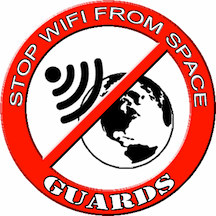Currently, a large number of technology companies are working on plans and even implementation (such as SpaceX) to offer WIFI from satellites (space), in order to make a profit and achieve global access. This is being planned seemingly without consideration for the serious health impacts, including cancers, which at least 237 scientists have warned the industry and UN about, from exposures to microwave and rf radiation. The updated “International Appeal: Stop 5G on Earth and in Space” has been signed by 26,740 scientists, physicians, experts, organizations, and individuals, as of Dec. 4, 2018. If WIFI signals are sent from satellites, blanketing the earth, this entirely unnatural and therefore inescapable, dangerous radiation will undoubtedly harm people and all living beings, as well as put the planet itself in peril. At this time, tech companies have so successfully lobbied government officials that the United States and other governments have approved of and are helping with these launches, in many cases. (CEP)
Global Union Against Radiation Deployment from Space (GUARDS)
An international coalition against global WIFI from space, a complex technology of radiation and toxic chemicals endangering all life on Earth
“Planned Global WiFi from Space Will Destroy Ozone Layer, Worsen Climate Change, and Threaten Life on Earth
“Thirteen companies are competing to cover the entire Earth with high-speed wireless Internet from low-orbit satellites within one to two years. This would be an ecological and public health nightmare. The biggest players are SpaceX (12,000 satellites), OneWeb (4,560 satellites) and Boeing (2,956 satellites). “
…
“Satellite Deployment Plans (according to the GUARDS website):
- SpaceX: 12,000 satellites, 1,200 km and 340 km high http://www.spacex.com/
- OneWeb: 2,000 satellites at 1,200 km and 2560 satellites at 8,500 km http://www.oneweb.world and http://www.cnbc.com/id/102340448
- Boeing: 2,956 satellites, 1,000 km high
- Samsung: 4,600 satellites, 930 miles high http://arxiv.org/ftp/arxiv/papers/1508/1508.02383.pdf
- Google: Approximately 100,000 high altitude balloons (62,500 feet) to achieve global coverage (“Project Loon”) http://www.google.com/loon/
- Telesat Canada: 117 satellites, multiple orbits http://spacenews.com/telesat-prepares-shareholder-payday-outlines-117-satellite-constellation/
- Theia Holdings: 120 satellites, low earth orbit https://www.fiercewireless.com/wireless/from-boeing-to-spacex-11-companies-looking-to-shake-up-satellite-space
- LeoSat MA: 108 satellites, low-earth orbit http://leosat.com/
- Iridium Next: 66 satellites, 483 miles high. An existing slow speed system. Launching of the “next generation” (higher speed) satellites is scheduled to begin in October 2015 and to be completed by 2017. https://www.iridium.com/about/IridiumNEXT.aspx
- Astrocast: 64 satellites for M2M/IoT https://advanced-television.com/2017/12/15/swiss-else-to-build-64-satellites-for-m2m-iot/
- O3b Networks: Has 16 satellites with aims to add more https://www.ses.com/networks/
- Kepler Communications: Planning satellites for a variety of wireless communication applications with polar orbits http://www.keplercommunications.com/about
- ViaSat: add 24 satellites, 8,200 km high https://www.fiercewireless.com/wireless/viasat-expects-viasat-2-to-make-it-more-competitive-cellular-s-unlimited-offerings
- Globalstar: 24 satellites, 880 miles high. Already in operation at slow data speeds. http://www.globalstar.com/en/index.php?cid=8200
- Karousel LLC: 4 satellites. http://assets.fiercemarkets.net/public/007-Telecom/karousel.pdf.
- Space Norway: 2 satellites. Deliver service to arctic region, including Alaska https://www.fiercewireless.com/wireless/from-boeing-to-spacex-11-companies-looking-to-shake-up-satellite-space.
- Audacy Corp.: Undetermined number of satellites at this time. https://audacy.space/. “



Comments are closed.